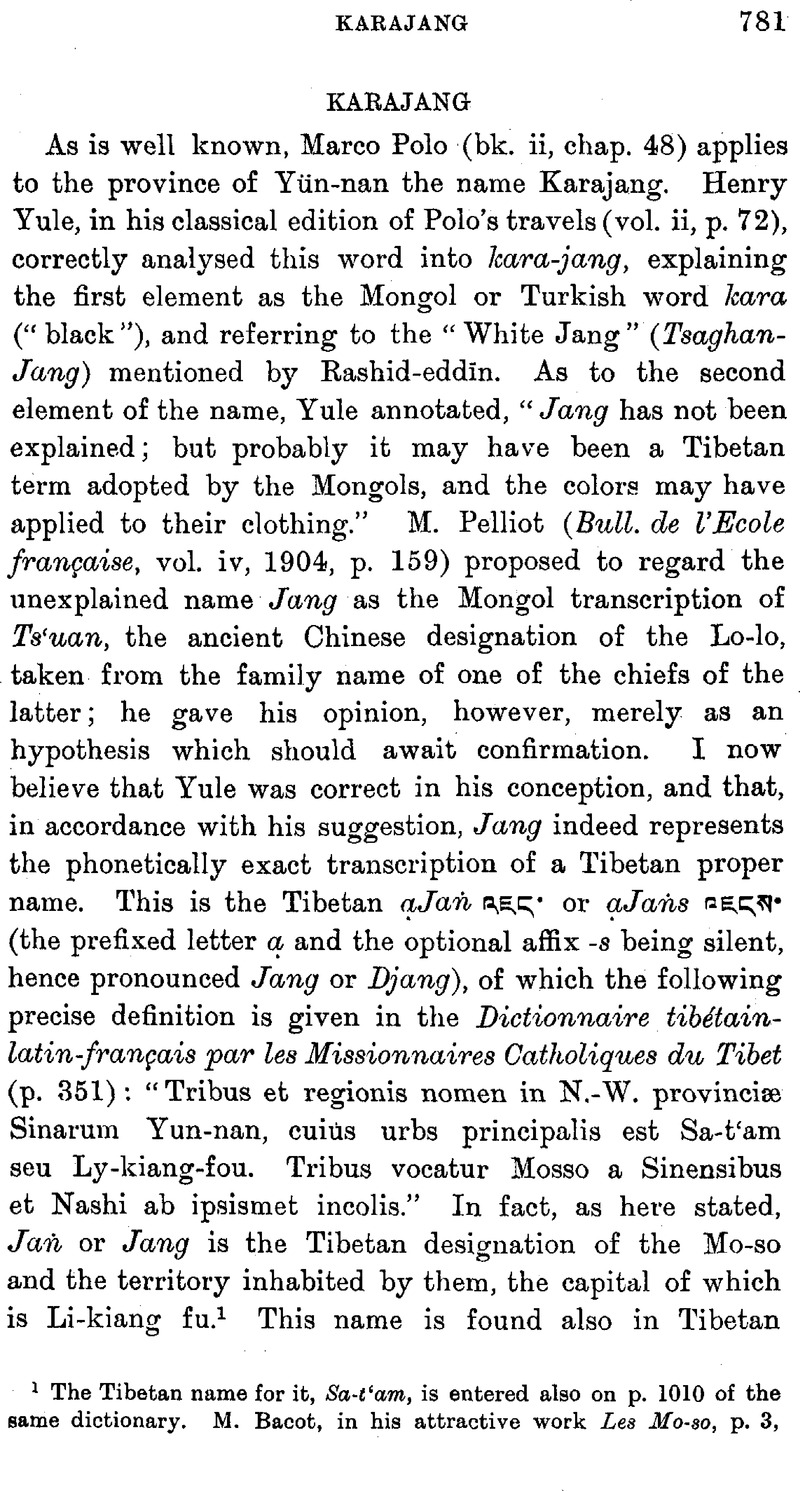No CrossRef data available.
Article contents
Karajang
Published online by Cambridge University Press: 15 March 2011
Abstract

- Type
- Miscellaneous Communications
- Information
- Copyright
- Copyright © The Royal Asiatic Society 1915
References
page 781 note 1 The Tibetan name for it, Sa-t'am, is entered also on p. 1010 of the same dictionary. Bacot, M., in his attractive work Les Mo-so, p. 3Google Scholar, transcribes the name Sa-dam. It is an interesting case that Bonin, M. (Les royaumes des neiges, p. 281)Google Scholar heard and rendered it in the form Sdam, as this illustrates the formation of a prefixed consonant, a phonetic phenomenon so peculiarly Tibetan (gradual elision of the vowel in the first element of a compound under the influence of a strong accentuation of the ultima).
page 782 note 1 Again (JASB., 1904, extra No., p. 98)Google Scholar, he explains the country Jang as Kuku-nōr region and Amdo. He cites also Sa-t'am as the “name of a place in K'am “from the writings of the Lama Kloṅ-rdol, so that there is no doubt that, as correctly stated by the French missionaries, Sa-t'am is the adopted form of the Tibetan written language. It is thus written also in the Tibetan Ge-sar Saga.
page 782 note 2 This information is usually credited to E. C. Baber (for instance, by de Lacouperie, T., Beginnings of Writing, p. 43Google Scholar; Devéria, G., Frontière sino-annamite, p. 164Google Scholar; Cordier, H., T'oung Pao, 1908, p. 670)Google Scholar: but Baber (Travels and Researches in Western China, p. 88Google Scholar, in Supplementary Papers, Roy. Geogr. Soc., vol. i, London, 1886) honestly acknowledged that he received this information from Mgr. Biet, Apostolic Vicar of Tibet in Ta-tsien-lu. Indeed, it is forestalled by Desgodins, in Annales de l'Extrême Orient, vol. ii, p. 133, Paris, 1880Google Scholar, and hence repeated in his book Le Tibet d'après la correspondance des missionnaires, 2nd ed., Paris, 1885, p. 369Google Scholar, where the curious transcription Guiong for the Tibetan name Jang appears, while Baber and his numerous followers wrote Djiung. T. de Lacouperie (loc. cit.) stated that Guiong is identical with Djiung, and from Bacot, M.'s book (Les Mo-so, p. 13)Google Scholar it appears that Djung, as he writes, is merely a variant of ạJang (Hdjang). The French missionaries themselves have never explained this diversity of names; in their dictionary (p. 253) they give with reference to the Ge-sar Saga only the form of the written language, ạJaṅs. The attention of future travellers in those regions may be called to this point; it would be interesting to see this possible dialectic change of a into u confirmed. Independent of the Tibetan studies carried on at Ta-tsien-lu, K. Marx, a Moravian missionary stationed at Leh, Ladāk, read in the Tibetan epic about Ge-sar's wars against the Jang (see JASB., vol. lx, p. 116, n. 13, 1891).Google Scholar
page 784 note 1 At first sight I was almost tempted to recognize the name Jang also in the T'ang Annals, as de Lacouperie, T. (Beginnings of Writing, p. 41)Google Scholar, following d'Hervey St.-Denys, mentions a tribal name Mo-tchang Man (thus also Cordier, , T'oung Pao, 1908, p. 664)Google Scholar. In looking up the text in the T'ang shu (Ch. 222A, p. 4b)Google Scholar I find, however, that this alleged tchang corresponds to ![]() , which reads shang; and shang could hardly be taken as the transcription of Tibetan ạJaṅ. As regards the phonetic relation of the latter to Chinese chang, compare the Tibetan transcriptions ạjam-mo (“post-stage”) and ạja-sa (“edict”), reproducing the Mongol words jam and jasa respectively, which were transcribed by the Chinese chan
, which reads shang; and shang could hardly be taken as the transcription of Tibetan ạJaṅ. As regards the phonetic relation of the latter to Chinese chang, compare the Tibetan transcriptions ạjam-mo (“post-stage”) and ạja-sa (“edict”), reproducing the Mongol words jam and jasa respectively, which were transcribed by the Chinese chan ![]() and cha-sa,
and cha-sa, ![]() (see Pelliot, , Journal asiatique, 1913, Mars-Avril, p. 458)Google Scholar. The Tibetan transcriptions, presumably modelled directly after the Mongol forms, are again shielded by the prefix ạ, which has neither a grammatical nor a graphic function, but a purely phonetic rôle, safeguarding the initial j from aspiration.
(see Pelliot, , Journal asiatique, 1913, Mars-Avril, p. 458)Google Scholar. The Tibetan transcriptions, presumably modelled directly after the Mongol forms, are again shielded by the prefix ạ, which has neither a grammatical nor a graphic function, but a purely phonetic rôle, safeguarding the initial j from aspiration.
page 784 note 2 Paris, 1911, pp. 249–304.


